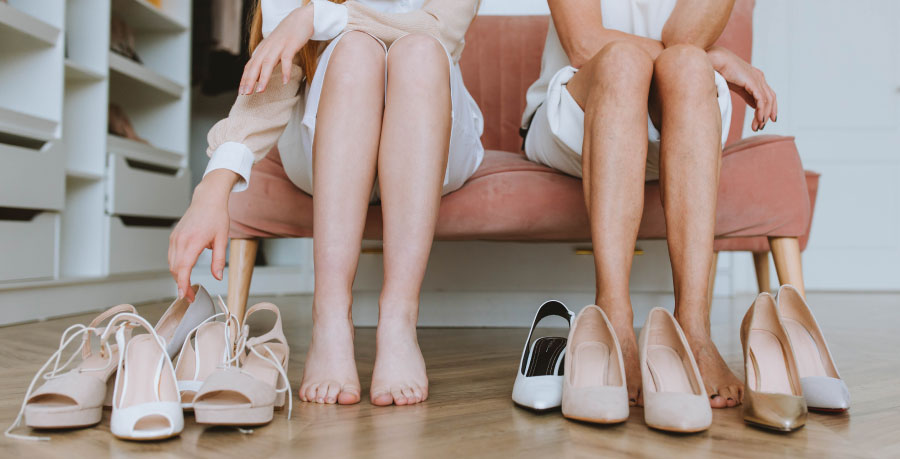Average 3000-10000 steps. A normally moving person walks so much a day, and it is very important what kind of shoes he does it with. So as not to hurt the feet.
How to choose shoes?
There are objective indicators of how our foot should feel in shoes.
First of all, comfortable - the right size!
Women in a shoe store also tend to think like this: "Leather shoes... After wearing them, they will stretch a little or I'll take them to the cobbler..." But such shoes, which need adaptation before you start wearing them at all, should not be bought.

Shoes must fit according to size - they don't need to be pushed anywhere. Basically, the size is the longest toe on our foot - the first or second, depending on which person - plus another 5-7 millimeters to spare. Therefore, if, when putting on the shoe in question, you can feel its wall with your longest toe, it is already too small. We will immediately feel this deficiency, as soon as the leg swells at the end of the day or we have walked a lot and stood for a long time - where the folded shoe will have rubbed against the shoe, a blister will appear.
Shoes and boots should be looked at at the end of the day, when the feet are already tired, maybe even swollen, and not in the morning, when the foot has rested and is definitely smaller. In addition, it is important to put the shoes on both feet when storing them.
When choosing a shoe size, remember!
Foot size is affected by:
- weight changes;
- daily load on the legs;
- also seasonality: in winter the footprint is usually a bit smaller than in summer. Therefore, summer shoes should be bought a little bigger than winter boots.
Second, comfortable, healthy shoes should have a small heel
– 3-5 centimeters high. Even flight attendants never walk around in high heels while on duty, though it is written in the dress code that shoes with a heel must be worn! Shoes with a heel higher than 5-6 centimeters should be reserved for special occasions and should not be worn for more than five hours a day. If they are boats with a heel of 11 centimeters, then four hours. In any case, it's not like you put it on at eight in the morning and take it off at nine in the evening. Because the wearers of such shoes sooner or later become our patients.

Another important indicator is the shoe sole. Each manufacturer has its own. One is not so perfect, the other has worked more on the lathe and it is better made. And yet, even if a woman feels wonderful in shoes with a heel higher than 5-6 centimeters, I cannot say that this is good for her health. Anyway, all the load rests more on the front part of the foot - on the toes.
What happens if we choose the wrong shoes?
Classic high heels with a pointed toe have a very narrow space for the toes and the load on the front part of the foot, the toe joints is very, very high. Ten times, if not more, than it should be. Especially if the wearer has a lot of weight. When improper foot support is formed, the toes are the first to suffer. The metatarsal bone at the base of the big toe or thumb shifts to the side. This place becomes inflamed, hurts because the shoes rub it. The stone gradually enlarges to form a growth. Over time, the thumb begins to lean on top of the other fingers, the second finger rises up. Then the deformation has progressed so far that the finished shoes will be difficult to fit. The so-called hammer toes are also formed from wearing unsuitable shoes - they rise up and remain in a half-bent position.
In the lower part of the fingers, various thickenings of the skin, corns, are formed, which interfere with life, because they hurt all the time.
A large load on the interphalangeal joints of the fingers in a bent position (a position in high-heeled shoes) shortens the foot on the longitudinal arch (this is the curvature along the inner edge of the foot from the base of the thumb to the heel) at the expense of elevation. Therefore, when later pulling on shoes even with a low heel, a person relies only on the toes and the heel. He also becomes our patient - we have to make special soles that hold the middle part of the foot. Otherwise, a person continues to lean on the toes - the deformation of the toes progresses, and the skin of the affected heel thickens and cracks. Due to the highly developed arch, heel spurs also occur - herniations in the shell of the bone caused by overload, through which the protruding tissue forms a small, hard growth or nail and, when the foot rests on the ground, causes severe pain.
The so-called ones are also not suitable for long-term wear horses with a strap between the fingers. In order for these shoes to stay on the feet, the muscles of the foot are constantly strained, and some parts of it are overloaded, which can lead to unwanted changes over time. The same is the case with the so-called ballet shoes, which do not have a heel.

